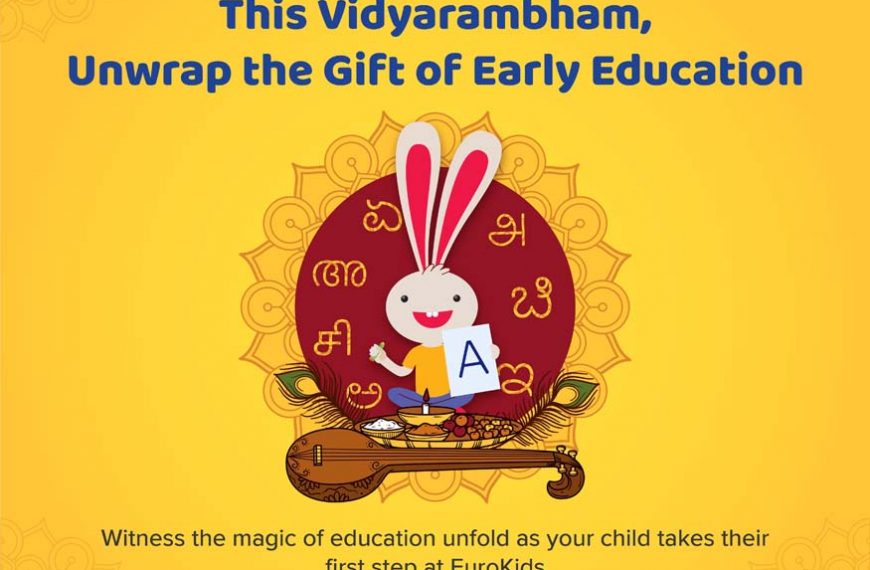The commencement of education is an important milestone in every child’s life. So it only makes sense to begin this journey on an auspicious note or with a traditional ceremony like Vidyarambham.
In traditional Hindu custom, Aksharabhyasam, also known as Vidyarambham, is the ceremonial induction of a child into the world of education. The word itself is an amalgamation of two terms: Akshara, meaning “alphabet,” and Abhyasam, meaning “study.” In this article, we will explore the Aksharabhyasam ceremony in detail.
What is Aksharabhyasam?
An inherent part of Indian culture and education, the Aksharabhyasam ceremony denotes Vidyarambha, which essentially translates to the initiation of education. The whole purpose of this ceremony is to seek the blessings of the gods, so they may assist the child in their academic journey.
Importance of Aksharabhyasam
1. Cultural Importance
Aksharabhyasam is a special ceremony that marks the beginning of a child’s learning journey. It highlights the importance of education in our culture and celebrates the child’s first step into formal schooling. This tradition reminds us that learning is not just a personal pursuit. It also benefits our society as a whole.
2. Spiritual Importance
In Hindu culture, gaining knowledge is seen as both a learning process and a spiritual journey. During Aksharabhyasam, prayers are offered to the gods, especially Goddess Saraswati, the goddess of wisdom and learning. The ceremony asks for blessings to help the child grow smarter and wiser, both in school and in life.
3. Emotional and Mental Importance
This ritual helps children feel excited and curious about the learning process. It creates a positive memory that makes starting school feel fun and special. Aksharabhyasam provides the child with a solid foundation, fostering confidence and a love for learning from the very beginning.
Also Read: The Impact of Family Traditions on Bonding and Connection
What Happens During the Aksharabhyasam Ceremony?
Aksharabhayasam is typically performed for children aged 2 to 5 years, who are in preschool and have yet to start their primary schooling. The ceremony is conducted to invoke Goddess Saraswati and Lord Ganesha to get divine blessings, which can help set your child up for success.
Here’s how the Aksharabhyasam ceremony is generally conducted:
- The Aksharabhyasam ceremony begins with the friends and family of the child and their parents joining in this auspicious occasion.
- A priest or an elder is called upon to conduct the Aksharabhyasam ceremony.
- Your child is sitting either in their father’s lap or the laps of their paternal or maternal uncle for the ceremony. Once both of them are comfortably seated, chant the following mantra as the priest instructs:
‘Saraswati Namstubhyam Varade Kama Rupini
Vidyarambham Karishyami Siddhir Bavatu Me Sada’
- Followed by this mantra to invoke the guru, Lord Ganesha and Goddess Saraswati:
‘Om Hari Sri Ganapataye Namaha
Avighnamastu, Sree Guruve Namaha
Sree Saraswati Sahayam’
- Once the chants are complete, the priest will fill a silver platter with rice and write the sacred ‘Om’ on the child’s tongue with gold, thereby imparting the blessings of wisdom and knowledge. Next, the child will be asked to write the first letter of their mother tongue on the rice using the forefinger of their right hand.
After this, a ceremonial offering of kheer (rice pudding) will be made to the goddess, which can then be distributed among all participants of the ritual. You can also distribute books, pens, pencils, or other educational items to underprivileged kids to mark this occasion.
Traditionally, the Aksharabhyasam or Vidyarambham ceremony is performed when the child reaches the age of 5. However, the growing awareness about early education in India has led parents to enrol their kids in kindergarten before formal schooling. Therefore, you can perform the vidyarambham ceremony as soon as your child starts preschool. However, the ceremony must be performed only on:
- Basant Panchami or Saraswati Puja
- Vijaya Dashami or Dussehra
- Guru Purnima
Which nakshatra is best suited for this ritual?
A sacred part of early education in India, you can choose any one of the following nakshatras to carry out this ceremony:
- Punarvasu
- Dhanishtha
- Swati
- Shatabhisha
- Ashwini
- Moola
- Hasta
- Pushya
- Mrighashira
- Purvashad
- Purvabhadrapad
- Chitra
- Purvaphalguni
What is the ideal venue to perform the Aksharabhyasam ceremony?
Any temple dedicated to goddess Saraswati will do. You can pick a renowned goddess Saraswati temple in your city or town and conduct this ceremony there. However, if that is not feasible, you have the option to perform Aksharabhyasam at home. Just be sure you have an image of goddess Saraswati and lord Ganesha at home.
What is the story behind the ancient practice of Aksharabhyasam?
In their quest, they came across Dandakaranya forest (now known as Basar) and found it to be just what they were looking for. They settled there, religiously conducting their daily spiritual exercises. At the end of each day, though, the sage Vyasa would bring back fistfuls of sand from the banks of the river Godavari and use it to make idols of goddess Saraswati (Sharada), Gouri and Lakshmi.
He consecrated the idols he formed with his spiritual prowess and began worshipping them at the banks of the river. This ancient spot then became the now famous Gnana Saraswati Temple in Basar, Telangana.
At this sacred temple, the idol of goddess Saraswati is smeared with turmeric, and it is believed that if you conduct your child’s Aksharabhyasam here, you could directly get the divine blessings of the goddess by getting a part of the turmeric paste applied on the goddess.
However, if you want to conduct Aksharabhyasam here, you must visit on the day of Vyasa Purnima, which falls on the day of the full moon in the Hindu month of Ashad. It is a very holy day.
What are the Benefits of the Vidyarambham Ceremony?
There are several reasons why you should perform this sacred Hindu ritual. Here are some of the benefits of performing the ceremony:
- It initiates your child’s education on a holy note. Consider it a stepping stone into the world of knowledge and wisdom.
- Aksharabhyasam is a celebration of victory, as it is observed in many states on the day of Vijaya Dashami. It is symbolic of the light of knowledge and wisdom that dispels the darkness of ignorance. It is the day when Icchha (will), Gyaan (knowledge) and Kriya (action) combine forces to bless people with wisdom.
- It marks the very special occasion of your child writing their first alphabet on rice or grain. The use of rice is not only auspicious, but it also connects your child to the rich land of customs and traditions that they belong to.
Aksharabhyasam Ceremony Across India
Although the main purpose of the Aksharabhyasam ceremony remains the same, the rituals differ from state to state. For instance, in Kerala, Aksharabhyasam is called Vidyarambham and is conducted by writing “Om” or “Shri” on rice grains. Let’s look at how the Aksharabhyasam ceremony is celebrated across the country.
1. Andhra Pradesh and Telangana
In these states, Aksharabhyasam is commonly known as Vidyarambham. It is usually performed at temples dedicated to Goddess Saraswati or at home with close family and friends. During the ceremony, children write their first letters on rice grains or on a slate using chalk. The ceremony is conducted on Vijayadashami.
2. Kerala
Kerala also celebrates Vidyarambham on Vijayadashami. Temples like Thunchan Parambu in Tirur and Mookambika Temple in Kollur see large crowds of children taking part in the ceremony. With help from parents, children write their first letters in rice or sand, asking for blessings from the Almighty.
3. Karnataka
In Karnataka, this ritual is called Akshara Sree or Vidyarambham. It usually takes place either in temples or at home. Children write their first letters on a plate of rice grains or on a slate. The ceremony is often performed on Vasant Panchami or Vijayadashami, and elders like parents, teachers, or priests guide the child during the ritual.
4. Tamil Nadu
Here, Aksharabhyasam is known as Ezhuthiniruthu or Vidyarambham. It is usually held in temples, such as the Koothanur Saraswati Temple, or at home. Children are encouraged to write their first letters on rice or a slate with support from parents or teachers. Vijayadashami is the most preferred day for the ceremony in Tamil Nadu.
5. West Bengal
In West Bengal, the ceremony is known as Hate Khori and is typically performed during Saraswati Puja, which falls on Vasant Panchami. Children use chalk or pens to write their first letters on a slate or paper, often in the presence of elders and family. The occasion includes prayers, blessings, and festive gatherings.
Tips for a Perfect Aksharabhyasam Ceremony
- Ask a priest or astrologer to help choose an auspicious day, so the ritual begins on a lucky note.
- Clean the house, decorate the puja area, and gather all the necessary items for the ritual beforehand.
- Involve family and close friends to make the event warm, memorable, and encouraging for the child.
- Maintain a cheerful and positive atmosphere so the child feels happy and excited to start their learning journey.
Conclusion
India is a truly fascinating land of customs and traditions, where each ritual has a deep-rooted meaning that adds significant value to the custom. At EuroKids, we try to inculcate curiosity and respect the ancient traditions of our nation. If you would like to learn more about how we impart education and knowledge to children, you can explore our learning curriculum.
If you are looking for more information on traditional ceremonies like Vidyarambham, check our blog, Hindu Birth Ceremonies & Facts. For more interesting blogs on your child’s learning and development, visit EuroKids Blogs. Don’t forget to check out EuroKids Preschools for the first step in your child’s learning journey.
Related Blogs:
- Exploring Food Cultures Around the World: Introduce your kids to the rich and diverse world of food! This blog examines the unique traditional dishes, eating habits, and food-related celebrations of various countries. It’s a fun and tasty way to help kids appreciate cultural differences while expanding their taste buds.
- Indian Folk Tales for Kids with Moral Lessons: This blog dives into classic Indian folk tales like Panchatantra and Jataka stories that not only entertain but also teach children valuable life lessons such as honesty, kindness, and teamwork.
- Why Celebrate Every Festival With Kids: Festivals are more than just fun. They are opportunities for young children to learn about tradition, culture, and togetherness. This blog examines how celebrating festivals fosters social awareness and a sense of belonging in preschoolers.
- The Importance of Indian Festivals for Kids: From Diwali to Pongal, every Indian festival carries its own charm and cultural significance. This blog explains how introducing children to these celebrations enhances their understanding of India’s diverse heritage and nurtures values like gratitude, joy, and unity.
















